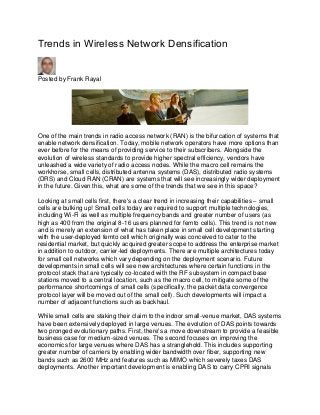
Trends in Wireless Network Densification
- 1. Trends in Wireless Network Densification Posted by Frank Rayal One of the main trends in radio access network (RAN) is the bifurcation of systems that enable network densification. Today, mobile network operators have more options than ever before for the means of providing service to their subscribers. Alongside the evolution of wireless standards to provide higher spectral efficiency, vendors have unleashed a wide variety of radio access nodes. While the macro cell remains the workhorse, small cells, distributed antenna systems (DAS), distributed radio systems (DRS) and Cloud RAN (CRAN) are systems that will see increasingly wider deployment in the future. Given this, what are some of the trends that we see in this space? Looking at small cells first, there's a clear trend in increasing their capabilities – small cells are bulking up! Small cells today are required to support multiple technologies, including Wi-Fi as well as multiple frequency bands and greater number of users (as high as 400 from the original 8-16 users planned for femto cells). This trend is not new and is merely an extension of what has taken place in small cell development starting with the user-deployed femto cell which originally was conceived to cater to the residential market, but quickly acquired greater scope to address the enterprise market in addition to outdoor, carrier-led deployments. There are multiple architectures today for small cell networks which vary depending on the deployment scenario. Future developments in small cells will see new architectures where certain functions in the protocol stack that are typically co-located with the RF subsystem in compact base stations moved to a central location, such as the macro cell, to mitigate some of the performance shortcomings of small cells (specifically, the packet data convergence protocol layer will be moved out of the small cell). Such developments will impact a number of adjacent functions such as backhaul. While small cells are staking their claim to the indoor small-venue market, DAS systems have been extensively deployed in large venues. The evolution of DAS points towards two pronged evolutionary paths. First, there's a move downstream to provide a feasible business case for medium-sized venues. The second focuses on improving the economics for large venues where DAS has a stranglehold. This includes supporting greater number of carriers by enabling wider bandwidth over fiber, supporting new bands such as 2600 MHz and features such as MIMO which severely taxes DAS deployments. Another important development is enabling DAS to carry CPRI signals
- 2. from a base station baseband unit over fiber to the DAS remote module which reduces cost as it eliminates the need to a radio at the feeder base station and related RF plumbing such as couplers, duplexers, attenuators and termination load. The third category of radio access nodes, DSRs, includes low-power remote radios that can be deployed similarly to small cells. In DSRs, the radios are connected to a macro cell either through fiber carrying CPRI signals, or over CAT5 cable (after CPRI is converted by an intermediary module to digital or intermediate frequency [IF] signals suitable for transmission over CAT5). DSRs are fundamentally a base station hotel which provides an improvement in performance over small cells because the remote radios can be coordinated with the macro cell that provides overlay coverage. This enables equipment vendors to implement their secret sauce to manage and mitigate interference within the context allowed by the access standard (such as LTE). This category has recently emerged to target medium sized venues where DAS can be too expensive to deploy and small cells can't scale effectively from both performance and practical perspectives. DSRs have certain limitations resulting from the capabilities of the remote radios and the type of connectivity to the baseband which limit the number of frequency carriers and distance. A fourth type of systems is in the process of emerging: Cloud RAN. While CRAN was originally conceived for a macro cell deployment scenario, its benefits translate well into the outdoor HetNet and indoor/in-venue deployment scenario. In fact, the performance advantage of CRAN is in its ability to enable coordinated multipoint, or network MIMO, capabilities. This is because in this architecture, the baseband processing is centralized, pooled and virtualized. Remote radios connect to baseband over fiber, but wireless fronthaul is also possible. CRAN would be a further evolution on DSRs which I believe will be supplanted by Cloud RAN once this technology is sufficiently mature. In reviewing these different types of access systems we should not forget that there are different approaches within each category which creates a very rich set of solutions at the disposal of operators. The question then becomes to what extent are these solutions complementary and competitive? Which will see wider deployments in the months and years ahead and which will fade away or perhaps evolve into a new type of system? For now, one thing is clear: the implications to the infrastructure ecosystems as well as to network operators, are perhaps greater than they have ever been.
